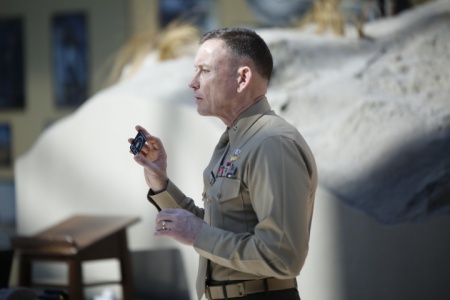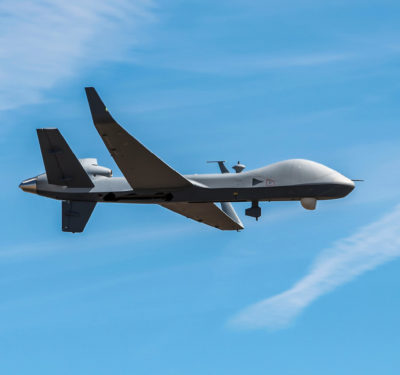
Retired Brig. Gen. Frank Kelley, former commander of Marine Corps Systems Command, will become the Navy’s first Deputy Assistant Secretary for Unmanned Systems. Photo by Carden Hedelt/Courtesy U.S. Defense Dept.
Navy Secretary Ray Mabus this week described a future where swarms of self-launching unmanned aircraft will cooperate to overwhelm an adversary and quad copters will be able to linger underwater before surfacing to fly.
Citing the promise and the threat posed by unmanned innovations, Mabus told the audience at AUVSI’s Unmanned Systems Defense 2015 that the Navy needed cohesive leadership for its unmanned programs. To that end he created the new post of Deputy Assistant Secretary of the Navy for Unmanned Systems (DASN), he said — a job, he told the crowd, that would be fill by retired Brig. Gen. Frank Kelley.
“His superb operational experience as a Marine, as well as his professional expertise in the field of electronic warfare and unmanned technology make him wonderfully qualified to lead this enterprise,” Mabus said.
Kelley will work with Rear Adm. Robert Girrier, who was tapped earlier this year to head N99, a new directorate within the Office of the Chief of Naval Operations (OPNAV) staff. Girrier will be responsible, explained Mabus, “for the rapid development prototyping and demonstration of our Navy unmanned systems warfare systems — because those unmanned systems are the platform of the future.”
Kelley will be tasked with working across the varied domains within the Navy — sea, land, air and undersea — to ensure that the Navy maintains its superiority in unmanned technology.
That technology varies widely. The service recently demonstrated the simultaneous, autonomous flight of 50 unmanned aircraft vehicles (UAVs), which were able to cooperate and exchange information with each other. A ship-based demo is planned for this spring with a swarm of up to 30 Coyote aircraft. This May the USS North Dakota — a Virginia-class, nuclear powered, fast-attack submarine — deployed and operated unmanned, undersea vehicles; the first such real-world operation. Congress has also made clear, Mabus told the crowd, that it wants to see the Navy develop a refuelable, unmanned aircraft that can launch from a carrier and operate in hostile airspace.
The Secretary said his goal in creating the DASN was to streamline the current structure and “drive a strategy for the development of these systems that’s deliberate and thoughtful.”
The Navy needs one central hub, he said, to make sure that across all the different domains and programs it has some centralized thinking about how to use these systems and use them together.
“As a military force,” he told attendees, “we absolutely cannot afford to lose in this realm.”






